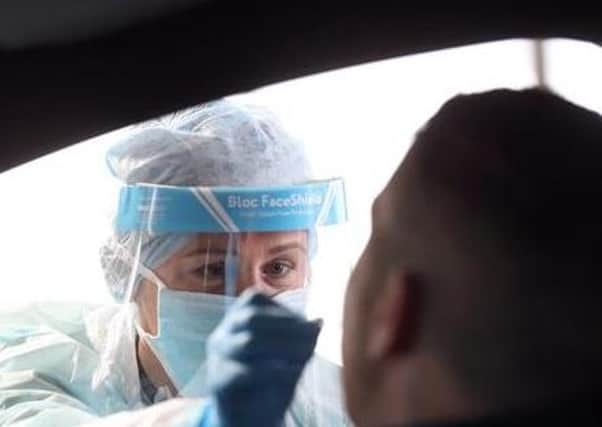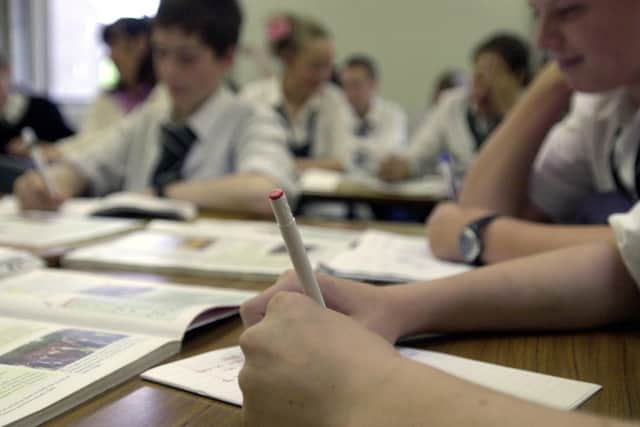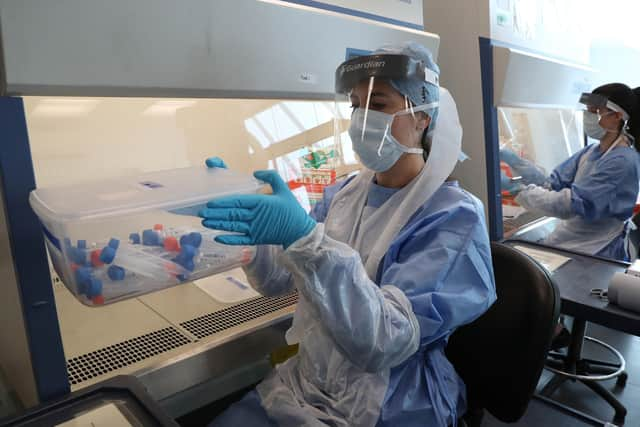LIVE BLOG Coronavirus NI: Ten people test positive in last 24 hours | 359 test positive in last 7 days | 6,776 test positive so far | most cases in Antrim and Newtownabbey area


The latest figures also reveal that 359 people have tested positive in the last 7 days - and 6,776 so far.
The latest stats reveal there is now one person fighting COVID-19 in ICU in a NI hospital.
Advertisement
Hide AdAdvertisement
Hide AdThere have been no further deaths - leaving the death toll at 559.


The Department of Health says of the ten new cases of coronavirus four of these are in the age range of 20 to 39 years, with three in the age bracket between 40 to 59 years.
Today’s stats also show the Antrim and Newtownabbey area to have the most new cases (5).
Meanwhile the Mid and East Antrim area and Belfast both saw two new cases, while there was one new case in Armagh, Banbridge, and Craigavon.
Advertisement
Hide AdAdvertisement
Hide AdIn the past week, the biggest spike in cases has been seen in the Mid and East Antrim area, where there have been 95 cases.


Earlier many pupils in years seven, 12 and 14 returned to school - for the first time since March due to the coronavirus pandemic.
Education Minister Peter Weir has said that opening schools was probably the “top priority” for the executive.
However, not all schools have been able to reopen.
In a statement Ballyclare Secondary has said it will not be opening on Monday after a pupil tested positive for Covid-19.
Advertisement
Hide AdAdvertisement
Hide AdThe principal of Ballyclare Secondary School said the pupil had been in the school on Thursday, 20 August and it would reopen on Tuesday.
On Friday it was announced that St Kevin’s Primary School on the Falls Road in west Belfast would not be reopening as planned after someone connected to the school tested positive for coronavirus.
And St Louise’s College, also on the Falls Road, also confirmed a positive case of Covid-19 among the school community.
Yesterday the Department of Health COVID-19 report revealsed that 119 people have tested positive in the last 24 hours.
Advertisement
Hide AdAdvertisement
Hide AdEarlier a statement was released from the Chief Medical Officers and Deputy Chief Medical Officers of England, Scotland, Northern Ireland and Wales on the evidence of risks and benefits to health from schools and childcare settings reopening.
It says: “The current global pandemic means that there are no risk-free options, but it is important that parents and teachers understand the balance of risks to achieve the best course of action for their children.
Children
We are confident that multiple sources of evidence show that a lack of schooling increases inequalities, reduces the life chances of children and can exacerbate physical and mental health issues. School improves health, learning, socialisation and opportunities throughout the life course including employment. It has not been possible to reduce societal inequalities through the provision of home-based education alone. School attendance is very important for children and young people.
We are confident in the extensive evidence that there is an exceptionally small risk of children of primary or secondary school age dying from COVID-19. The infection fatality rate (proportion of those who are infected who die) for those aged 5 to 14 is estimated at 14 per million, lower than for most seasonal flu infections. Every death of a child is a tragedy but COVID-19 deaths in children and teenagers are fortunately extremely rare and almost all deaths are in children with significant pre-existing health conditions.
Advertisement
Hide AdAdvertisement
Hide AdWe are confident that there is clear evidence of a very low rate of severe disease in children of primary and secondary school ages compared to adults, even if they catch COVID-19. The percentage of symptomatic cases requiring hospitalisation is estimated to be 0.1% for children aged 0 to 9 and 0.3% among those aged 10 to 19, compared to a hospitalisation rate of over 4% in the UK for the general population. Most of these children make a rapid recovery.
We are confident that there is clear evidence from many studies that the great majority of children and teenagers who catch COVID-19 have mild symptoms or no symptoms at all.
There is reasonable, but not yet conclusive, evidence that primary school age children have a significantly lower rate of infection than adults (they are less likely to catch it).
Evidence that older children and teenagers are at lower risk of catching COVID-19 is mixed. They are either less likely to catch COVID-19 than adults or have the same risk as adults.
Advertisement
Hide AdAdvertisement
Hide AdTransmission of COVID-19 to children in schools does occur. On current evidence it is probably not a common route of transmission. It may be lower in primary age children than secondary age children.
Control measures such as hand and surface hygiene, cohorting to reduce number of daily contacts, and directional controls to reduce face-to-face contact remain key elements of maintaining COVID-19 secure school environments and minimising risk.
Children and young people who were previously shielding were identified on a precautionary basis at a stage when we had less data on the effects of COVID-19 in children than we do now. Based on our better understanding of COVID-19 the great majority have now been advised they do not need to do so again, and that they should return to school. A small number of children under paediatric care (such as recent transplant or very immunosuppressed children) have been or will be given individual advice about any ongoing need to avoid infection.
Our overall consensus is that, compared to adults, children may have a lower risk of catching COVID-19 (lowest in younger children), definitely have a much lower rate of hospitalisation and severe disease, and an exceptionally low risk of dying from COVID-19. Very few, if any, children or teenagers will come to long-term harm from COVID-19 due solely to attending school. This has to be set against a certainty of long-term harm to many children and young people from not attending school.
Teachers, other school staff and parents
Advertisement
Hide AdAdvertisement
Hide AdData from the UK (Office for National Statistics (ONS)) suggest teachers are not at increased risk of dying from COVID-19 compared to the general working-age population. ONS data identifies teaching as a lower risk profession (no profession is zero risk). International data support this.
Transmission of COVID-19 to staff members in school does occur, and data from UK and international studies suggest it may largely be staff to staff (like other workplaces) rather than pupil to staff. This reinforces the need to maintain social distancing and good infection control inside and outside classroom settings, particularly between staff members and between older children and adults.
If teachers, other school staff, parents or wider family catch COVID-19 their risks of severe illness are similar to those of other adults of the same age, ethnicity and health status. Younger adults have a much lower risk of severe COVID-19 than older adults. The greatest risk is to those over 80 years old.
Current international evidence suggests transmission of COVID-19 from children of school age to parents or other adult family members is relatively rare compared to transmission from adults, but this evidence is weak. Teenagers may be more likely to transmit to adults than younger children.
Advertisement
Hide AdAdvertisement
Hide AdChildren and young people should be engaged in the process of establishing COVID-19 secure measures as key participants and promoters of safe communities to help protect their wider families, teachers and other school staff and other social networks. This will help reduce the risk of school outbreaks.
Impact of opening schools on wider transmission (R)
Because schools connect households it is likely opening schools will put some upward pressure on transmission more widely and therefore increase R. We have confidence in the current evidence that schools are much less important in the transmission of COVID-19 than for influenza or some other respiratory infections. Other work and social environments also increase risk and are likely to be more important for transmission of COVID-19.
The international real-world evidence suggests that reopening of schools has usually not been followed by a surge of COVID-19 in a timescale that implies schools are the principal reason for the surge. There has, however, not been sufficient time to say this with confidence.
On the other hand, a local or national surge in transmission in the community may lead to an increased risk of school outbreaks occurring.
Advertisement
Hide AdAdvertisement
Hide AdOpening schools may be as important in linking households indirectly as through direct transmission in school. For example allowing parents to go back to work, or meeting at the school gates, on public transport or in shared private vehicles, via after school social or sport activities or wrap-around care may be as important as what happens within the school.
It is possible that opening schools will provide enough upward pressure on R that it goes above 1 having previously been below it, at least in some local areas. This will require local action and could mean societal choices that weigh up the implications of imposing limitations on different parts of the community and the economy.
Early identification and quickly managing outbreaks of COVID-19 in schools is essential as part of a local response to COVID-19. Clear advice for pupils and staff not to attend school with symptoms, and prompt availability of testing, appropriate isolation advice, and careful public health surveillance and monitoring of educational establishments are key to support the safe return to schools”.
_________________________________________________
A message from the Editor:
Thank you for reading this story on our website. While I have your attention, I also have an important request to make of you.
Advertisement
Hide AdAdvertisement
Hide AdWith the coronavirus lockdown having a major impact on many of our advertisers - and consequently the revenue we receive - we are more reliant than ever on you taking out a digital subscription.
Subscribe to newsletter.co.uk and enjoy unlimited access to the best Northern Ireland and UK news and information online and on our app. With a digital subscription, you can read more than 5 articles, see fewer ads, enjoy faster load times, and get access to exclusive newsletters and content. Visit https://www.newsletter.co.uk/subscriptions now to sign up.
Our journalism costs money and we rely on advertising, print and digital revenues to help to support them. By supporting us, we are able to support you in providing trusted, fact-checked content for this website.
Alistair Bushe
Editor